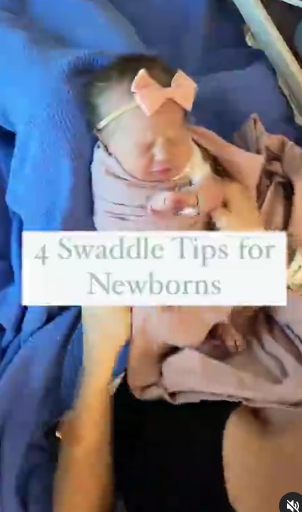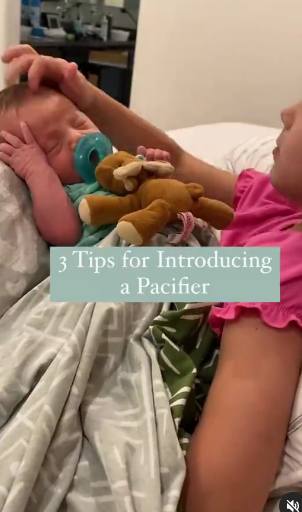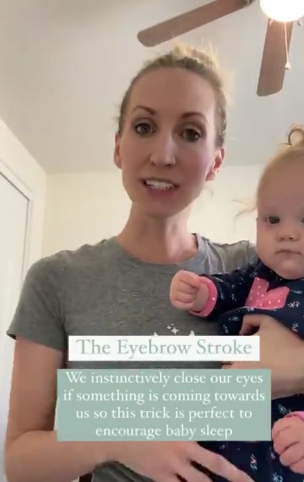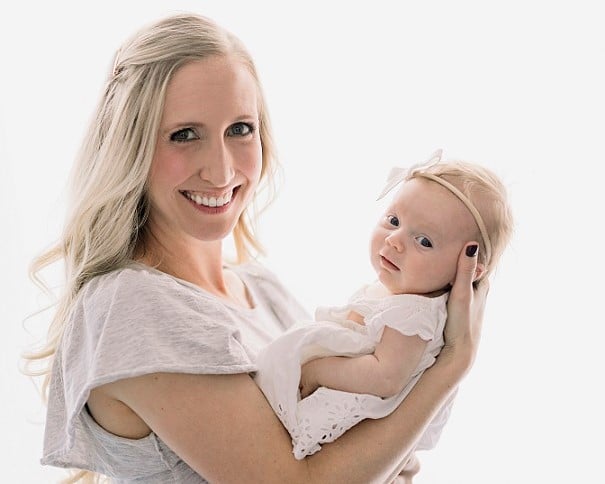I’m sure you’ve heard the term “sleep regression” before having your baby, however nothing can quite prepare you for when that first one hits: the 6-week sleep regression.
When you first bring your newborn home, they pretty much sleep all the time. (Except when they are eating and pooping, of course.) And you are pretty maxed out with postpartum healing, sanitizing pacifiers, bottles and pump parts, the never-ending laundry, navigating hormonal changes, and wondering if you will ever eat dinner sitting at the table again. So when suddenly your newborn starts waking more in the night, taking longer to fall asleep, and generally fighting sleep, it can feel like a shocking slap in the face.
Please know that this sleep regression can throw even the most seasoned parents for a loop. We’ve all been there, and it’s just really not a good time.
So in this blog post, I’m going to fill you in on how long the 6-week sleep regression lasts, how you know you’re entering the regression, and how to get through it. And just a note, this regression can happen as late as 7 or 8 weeks, but typically you’ll see it at 6 weeks!
I hope it can help you feel empowered that this regression is completely normal, and give you some useful tips and tricks for getting your newborn’s sleep back on track!
Here’s what we will cover:
How long does the 6-week sleep regression last, and why does it happen?
Signs and symptoms of the 6-week sleep regression
How to survive the 6-week sleep regression
How long does the 6-week sleep regression last, and why does it happen?

The short answer is, most sleep regressions last around 2 weeks. But that all depends…
The long answer is it depends on the baby and, especially for this sleep regression, it depends on how successful preventing overtiredness and implementing good sleep habits is. (More on this in the “how to survive the 6-week sleep regression” section.)
Around 6-8 weeks, newborns start to become more alert. They are more interested in their surroundings, so they start to push through their sleepiness and enter the dreaded zone of overtiredness. When babies are overtired (and this is especially true for younger babies) it becomes very hard for them to sleep. They fight the sleepy chemicals and become “wired”.
The key is to prevent overtiredness and implement strategies to get your baby’s sleep back on track as quickly as possible.
How? Keep reading!
Signs and symptoms of the 6-week sleep regression

As I previously mentioned, around 6-8 weeks, many babies no longer effortlessly drift off to sleep. When you once were able to put very little thought into getting your newborn to sleep, now they are much more aware of the world around them and start to fight off sleep.
As you enter the 6-week sleep regression, you may also notice the following:
- Your baby is no longer falling asleep in spaces that are loud and bright
- Increase in fussiness
- Seem sleepy and squirmy, but are not going to sleep easily
If this sounds like your little one, I’m sorry to have to tell you, but you are most likely entering (or have already embarked on!) the 6-week sleep regression.
How to survive the 6-week sleep regression
Here is where we have come to the real information you are looking for. The life raft that will carry you to the sweet release of safety from this regression.
So your newborn is no longer “sleeping like a baby” and inching into overtiredness is causing a serious lack of sleep. This is totally normal for the 6-week sleep regression and here is what you are going to do to put an end to it, and get your baby’s sleep back on track.
1. Prevent Overtiredness
Preventing overtiredness is the key. And the way to do this is to get your newborn to sleep before they become tired. You actually want to get them to sleep when they are SLEEPY (not tired). Newborns have very short wake windows (60-90 min and 90-120 min before bedtime). AND they have sleepy cues that tell you exactly when to get your newborn to sleep. So watch the clock and watch for sleepy cues, and as soon as it’s around the 60-minute mark and you see a sleepy cue or two, get your newborn to sleep!
2. Calming Tricks
The 6-week sleep regression can be a little jarring, so in addition to preventing overtiredness, you can also stack on some calming tricks to help sooth your newborn so they drift off to sleep easier.
Here are my Six S’s
Swaddle: Use a snug swaddle that isn’t too tight that it restricts hip movement, but isn’t too loose that it can come undone. For more tips on swaddling, click here or on the image below.
Suck: Babies are soothed by sucking, so offering a pacifier can be helpful! It’s normal for it to take some time for baby to get the hang of it, so keep practicing. For tips on helping your baby take a pacifier, click here or on the image below.
Shushing: Mimic the sounds of the womb by making a whooshing sound in baby’s ear, or use a sound machine.
Side Position: Always put baby to sleep on their back, but if you are doing a contact nap where you are awake and supervising, have your baby lie on their side, snug to your body to mitigate their Moro reflex.
Swing: Babies love motion, so you can rock or gently jiggle your baby against the side of your body.
Stroke: Stroke your baby’s eyebrows or run your fingers from their forehead down their nose. Babies find this soothing and it encourages them to close their eyes. To see the eyebrow stroke in action, click here or on the image below.
3. You can’t spoil a newborn
Sometimes we just need to pull out all the stops to get our baby to sleep, and this is very true during the 6-week sleep regression. Some parents think that they have to be careful not to reinforce “bad” sleep habits, however this is not true for newborns. You can’t spoil a newborn, so you are free to do whatever you need to do to get your newborn to sleep without worrying that it will “ruin” their future sleep. This may mean rocking, car naps, carrier naps, contact naps, nursing to sleep, etc. Yes, it is great to practice independent sleep skills and to try and feed before sleep not TO sleep, however what’s most important during the newborn phase is to prevent overtiredness and get your newborn the sleep they need. And sleep begets sleep!
4. Prevent Overstimulation
Yes, newborns can usually sleep anytime, anywhere, however once the 6-week sleep regression hits, it’s a little tricker to get your newborn to sleep so be cognizant of overstimulation.
If your newborn has been awake for 60 minutes and doesn’t look like they are going to fall asleep anytime soon, get to a dark, quiet space and try some calming tricks.
If you are out and about, and it’s time for your little one to sleep, use a portable sound machine, and a well-ventilated car seat cover to help create a dark, comfortable sleep space that is free of stimulation.
6-week sleep regression recap & next steps
The most important thing to remember is that sleep regressions don’t last forever, even at 6 weeks! I mean, that’s not super comforting as this is the first of many sleep regressions headed your way…. but no need to dwell on that right now! One step at a time, you’ve got this!
However, if this is something you are concerned about, I have a whole troubleshooting guide titled “Sleep Regressions, Teething and Illness” in my Newborn Guide Pack, part of the 0-4 Months Content Library.
My 0-4 Months Content Library, with a full video course and written guides, teaches you the fundamentals of healthy sleep, and how to decipher your baby’s cues to meet their needs.
You’ll learn exactly what you need to do to keep them happy, content, and sleeping well!
Access the 0-4 Months Content Library here!







0 Comments